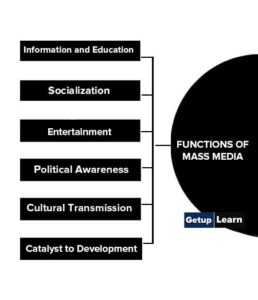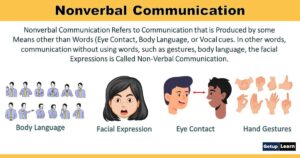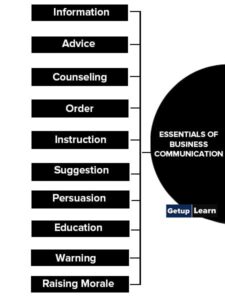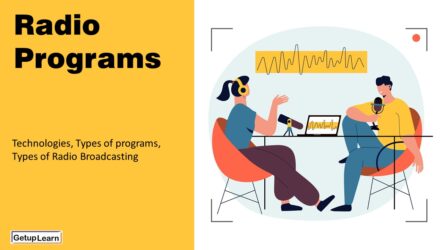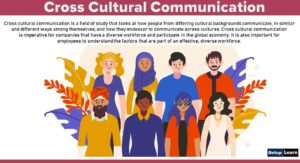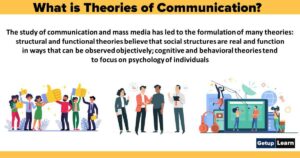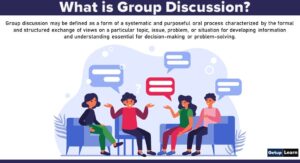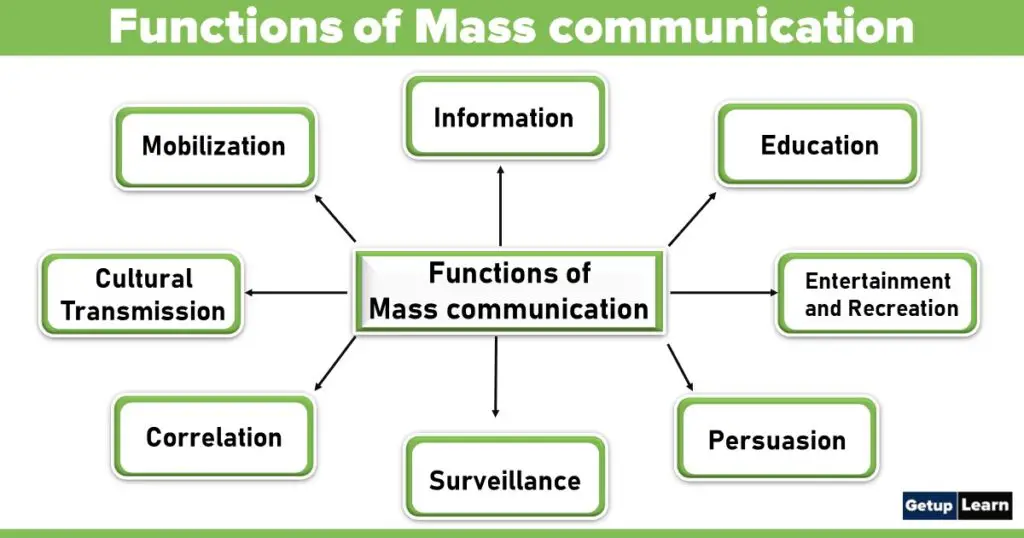
Table of Contents
8 Functions of Mass communication
The primary functions of mass communication are (a) Information (b) Education (c) Entertainment and Recreation (d) Persuasion. The secondary functions of mass communication are (a) the Watchdog function and (b) the torch-bearing Function.
The watchdog function relates to surveillance and the torch-bearing function relates to a correlation, cultural transmission, and mobilization. In fact, Lasswell 1948 in his deep study determined three functions of mass communication as Surveillance of the environment, Correlation of the parts of the society in response to its environment, and transmission of cultural heritage.
In 1960, Wright added yet another function called Entertainment and Recreation. In 1987, Dennis McQuail added a few more in his pioneering book entitled“Mass Communication Theory”.These are Information, Education, Persuasion, and Mobilisation.
These are the functions of mass communication:
- Information
- Education
- Entertainment and Recreation
- Persuasion
- Surveillance
- Correlation
- Cultural Transmission
- Mobilization
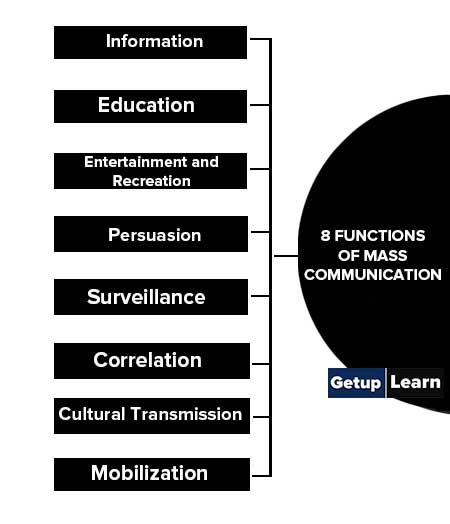
Information
Man is a social animal. He has to live in the company of other people in close proximity. Information is the only link and even linchpin of society. Hence, the first function of any mass media is to inform its diversified, heterogeneous, anonymous, and shapeless audience.
It has to keep people alert with the latest news and tidings in our own region and around the world. Different mass media have different target audiences. Hence they inform different categories of people differently and specifically.
In our rural society, the word- of- the mouth technique is still the most popular and prevalent means of disseminating news. Thus mass media as an informant should provide information about events and conditions in society and the world, indicate relations of power, and facilitate innovation, adaption, and progress.
Education
Education is the creation of awareness through the thoughtful interpretation of information. Mass communication provides a broad platform with a lot of opportunities for presenting diverse news, views, reviews, interviews, previews, and solutions, models for several problems, issues, and environmental initiatives.
Apart from that, being serious analyzers of such issues and problems day in and day out, the mass media agencies develop certain expertise in such matters. And thereby educate people by creating awareness about what course of action is to be taken in a movement of extreme crisis.
Entertainment and Recreation
This is another very important function of mass communication. Many people are dependent on mass media purely for entertainment and recreation. They help to pass the time easily and to relax comfortably with friends and family members.
It removes the monotony of our life by providing entertainment and aesthetic recreation. Films and television soap opera serials help us fully harness our leisure time. But they also tell us how things were or how things could be. Thus, mass media as an entertainer should provide amusement, diversion, and means of relaxation.
Persuasion
This means bringing about certain changes in the mindset of the audience. Mass media tries to bring about positive changes in the mass audience by informing, educating, and entertaining them. Sometimes mass media uses the mechanism of infotainment, edutainment, and infotainment also.
Surveillance
As discussed earlier, Harlod D, Lasswell (1948) and Wright (1960) deliberated upon their function of mass communication in which both emphasized surveillance, correlation, cultural transmission, entertainment, and recreation as major functions of mass communication. In addition to the descriptive interpretation by Dennis McQuail (1987) mobilization, education, information, and persuasion are nonetheless- significant and equally important functions of communication.
The mass media as their watchdog role are often proffered with the responsibility of keeping watch over society and unearthing and apprising the members of that society of information that may be of concern to them. Mass media is also supposed to interpret such information.
It is the function of the mass media to create awareness by disseminating the information on what is happening and of methods in which the calamities can be copied by adding even the hidden aspects of the fact. For example, in a situation of war, natural disasters, health hazards, etc. It is the function of the mass media to create awareness by disseminating information on what is happening and methods by which calamities can be coped up.
Correlation
This function of mass communication mainly relates to how media’s selection of certain news items and their interpretation attracts and how society perceives and reacts to it. Mass audience attitudes towards political issues, events, public policy, etc. are influenced to an extent by how mass media produces and frames the issues in their discussions and discourses.
For example, Hitler correlated his major political issues and exercised the mass media in his propaganda war against the Jews. Thus mass media as correlating units should explain, interpret and comment on the meaning of events of information.
It should provide support for established authority and norms. It should help socialize and coordinate separate activities. It should be instrumental in consensus building and setting orders of priority and signaling relative status.
Cultural Transmission
This function of mass communication relates to the power and potentiality of the mass media to teach the prevailing norms, orders, values and rules that exist in a society and ensures the transmission from one generation to another the newer and younger generation.
The mass media also transmit cultural norms by interpreting the information that passes through the gates. Moreover, cultural transmission is executed through the different forms of entertainment items produced by the media. For example shows like Lassie, Full Home, Seventh Heaven, and the Brandy Bunchmotivated, correlated, and promoted family norms and values.
Mobilization
Yet another important function of media is mobilization in which the media tries to promote society’s interest, especially in times of crisis. Here the media mobilizes public attitude in favor of the development of society, polity, economy, education, culture, religion, and spiritualism. Thus, mass media as a mobilizing agent should campaign for social objectives in the sphere of politics, war, economic development, social work, and sometimes religion.
Read More Related Articles
[su_spoiler title=”What is Communication? | Mass Communication” style=”fancy” icon=”plus-circle”]
What is Communication?
[/su_spoiler]
[su_spoiler title=”Types of Communication | Principles of Communication” style=”fancy” icon=”plus-circle”]
-
Types of Communication
- Verbal Communication
- Non-Verbal Communication
- Written Communication
- Visual Communication
- Feedback Communication
- Mass Communication
- Group Communication
[/su_spoiler]
[su_spoiler title=”Nonverbal Communication | Verbal Communication” style=”fancy” icon=”plus-circle”]
[/su_spoiler]
[su_spoiler title=”Written Communication | Oral Communication” style=”fancy” icon=”plus-circle”]
Written Communication
[/su_spoiler]
[su_spoiler title=”Business Communication | Organizational Communication” style=”fancy” icon=”plus-circle”]
[/su_spoiler]
[su_spoiler title=”Formal Communication | Informal Communication” style=”fancy” icon=”plus-circle”]
[/su_spoiler]
[su_spoiler title=”Interpersonal Communication | Informal Communication” style=”fancy” icon=”plus-circle”]
[/su_spoiler]
[su_spoiler title=”Downward Communication | Upward Communication” style=”fancy” icon=”plus-circle”]
[/su_spoiler]
[su_spoiler title=”Barriers to Communication | Horizontal or Lateral Communication” style=”fancy” icon=”plus-circle”]
[/su_spoiler]
[su_spoiler title=”Self Development | Effective Communication” style=”fancy” icon=”plus-circle”]
[/su_spoiler]
[su_spoiler title=”Difference Between Oral and Written Communication | Theories of Communication” style=”fancy” icon=”plus-circle”]
[/su_spoiler]
What are the 8 functions of mass communication?
Following are the 8 functions of mass communication given below:
1. Information
2. Education
3. Entertainment and Recreation
4. Persuasion
5. Surveillance
6. Correlation
7. Cultural Transmission
8. Mobilization.

